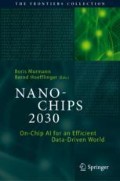Abstract
This chapter presents the use of Monolithic 3D technologies to overcome the interconnect barrier between the processing logic and the high-speed memory—the so-called “Memory Wall.” This barrier is even more limiting for AI applications in which massive amounts of data need to go through relatively simple processing. The 2018 3DVLSI DARPA program is focused on addressing this challenge. Alternative technologies are covered in which layers of logic and layers of memory can be integrated to construct efficient AI systems. This chapter also describes the use of 3D technology to enable ultra large-scale integration with efficient across-system interconnecting technologies.
Access this chapter
Tax calculation will be finalised at checkout
Purchases are for personal use only
References
J.L. Hennessy, D.A. Patterson, Computer Architecture: A Quantitative Approach (Elsevier, 2011)
D. Efnusheva, A. Cholakoska, A. Tentov, A survey of different approaches for overcoming the processor—memory bottleneck. Int. J. Comput. Sci. Inf. Technol. 9(2), 151–163 (2017)
H. Simon, Why we need Exascale and why we won’t get there by 2020, in Optical Interconnects Conference, Santa Fe, New Mexico (2013)
M.M.S. Aly et al., Energy-efficient abundant-data computing: the N3XT 1,000 x. Computer 48(12), 24–33 (2015)
W. Hwang et al., 3D nanosystems enable embedded abundant-data computing: special session paper, in Proceedings of the Twelfth IEEE/ACM/IFIP International Conference on Hardware/Software Codesign and System Synthesis Companion (ACM, 2017)
S. Mitra, Abundant-data computing: the N3XT 1,000 X, in 2018 International Symposium on VLSI Design, Automation and Test (VLSI-DAT) (IEEE, 2018)
Z. Or-Bach, A 1,000x improvement in computer systems by bridging the processor-memory gap, in 2017 IEEE SOI-3D-Subthreshold Microelectronics Technology Unified Conference (S3S) (IEEE, 2017)
R.J. Gutmann et al., Wafer-level via-first 3D integration with hybrid-bonding of Cu/BCB redistribution layers, in Proceedings of the International Wafer Level Packaging Congress (IWLPC) (2005)
A. Jourdain et al., Simultaneous Cu-Cu and compliant dielectric bonding for 3D stacking of ICs, in 2007 IEEE International Interconnect Technology Conference (IEEE, 2007)
F. Liu et al., A 300-mm wafer-level three-dimensional integration scheme using tungsten through-silicon via and hybrid Cu-adhesive bonding, in 2008 IEEE International Electron Devices Meeting (IEEE, 2008)
A. Jourdain et al., Electrically yielding collective hybrid bonding for 3D stacking of ICs, in 2009 59th Electronic Components and Technology Conference (IEEE, 2009)
T. Uhrmann, J. Burggraf, M. Eibelhuber, Heterogeneous integration by collective die-to-wafer bonding, in 2018 International Wafer Level Packaging Conference (IWLPC) (IEEE, 2018)
Patent Application WO 2018/071143 in reference to Fig 11F-11H
Patent Application WO 2019/060798
S.W. Tam, M.-C.F. Chang, RF/wireless-interconnect: the next wave of connectivity. Sci. China Inf. Sci. 54(5), 1026–1038 (2011)
S.-W. Tam, M. Frank Chang, J. Kim, Wireline and wireless RF-interconnect for next generation SoC systems, in 2011 IEEE 54th International Midwest Symposium on Circuits and Systems (MWSCAS) (IEEE, 2011)
M.F. Chang et al., CMP network-on-chip overlaid with multi-band RF-interconnect, in 2008 IEEE 14th International Symposium on High Performance Computer Architecture (IEEE, 2008)
U.S. Patent 7,964,916 (Fig. 41)
U.S. Patent 8,395,191 (Fig. 114–132)
U.S. Patent 10,014,318
W. Flack et al., Large area interposer lithography, in Electronic Components and Technology Conference (ECTC), 2014 IEEE 64th (IEEE, 2014)
Hao et al., Demonstration of 3–5 μm RDL line lithography on panel-based glass interposers, in Electronic Components and Technology Conference (ECTC), 2014 IEEE 64th
Y. Arakawa et al., Silicon photonics for next generation system integration platform. IEEE Commun. Mag. 51(3) (2013)
C. Xiao, Z. Huang, D. Li, A tutorial for key problems in the design of hybrid hierarchical noc architectures with wireless/rf. SmartCR 3(6), 425–436 (2013)
S. Deb et al., Wireless NoC as interconnection backbone for multicore chips: promises and challenges. IEEE J. Emerg. Sel. Top. Circuits Syst. 2(2), 228–239 (2012)
S-W. Tam et al., A simultaneous tri-band on-chip RF-interconnect for future network-on-chip, in 2009 Symposium on VLSI Circuits (IEEE, 2009)
B. Sawyer et al., Modeling, design, and demonstration of 2.5 D glass interposers for 16-channel 28 Gbps signaling applications, in Electronic Components and Technology Conference (ECTC), 2015 IEEE 65th (IEEE, 2015)
A. Brière et al., A dynamically reconfigurable rf noc for many-core, in Proceedings of the 25th Edition on Great Lakes Symposium on VLSI (ACM, 2015)
A. Carpenter et al., Using transmission lines for global on-chip communication. IEEE J. Emerg. Sel. Top. Circuits Syst. 2(2), 183–193 (2012)
M.R. Yahya et al., Review of photonic and hybrid on chip interconnects for MPSoCs in IoT paradigm, in 2018 21st Saudi Computer Society National Computer Conference (NCC) (IEEE, 2018)
A. Kumar et al., Toward human-scale brain computing using 3D wafer scale integration. ACM J. Emerg. Technol. Comput. Syst. (JETC) 13(3), 45 (2017)
Z. Wan, Three-dimensional wafer scale integration for ultra-large-scale neuromorphic systems. Diss. UCLA (2017)
Z. Wan, S.S. Iyer, Three-dimensional wafer scale integration for ultra-large-scale cognitive systems, in SOI-3D-Subthreshold Microelectronics Technology Unified Conference (S3S), 2017 IEEE (IEEE, 2017)
S. Pal et al., Architecting waferscale processors-a GPU case study, in 2019 IEEE International Symposium on High Performance Computer Architecture (HPCA) (IEEE, 2019)
M.S. Bakir et al., 3D integrated circuits: liquid cooling and power delivery. IETE Tech. Rev. 26(6), 407–416 (2009)
A. Bar-Cohen, J.J. Maurer, D.H. Altman, Gen3 embedded cooling for high power RF components, in 2017 IEEE International Conference on Microwaves, Antennas, Communications and Electronic Systems (COMCAS) (IEEE, 2017)
J.-H. Han et al., Microfluidic cooling for 3D-IC with 3D printing package (IEEE S3S, 2019)
A. Karkar et al., A survey of emerging interconnects for on-chip efficient multicast and broadcast in many-cores. IEEE Circuits Syst. Mag. 16(1), 58–72 (2016)
Author information
Authors and Affiliations
Corresponding author
Editor information
Editors and Affiliations
Rights and permissions
Copyright information
© 2020 Springer Nature Switzerland AG
About this chapter
Cite this chapter
Or-Bach, Z. (2020). A 1000× Improvement of the Processor-Memory Gap. In: Murmann, B., Hoefflinger, B. (eds) NANO-CHIPS 2030. The Frontiers Collection. Springer, Cham. https://doi.org/10.1007/978-3-030-18338-7_15
Download citation
DOI: https://doi.org/10.1007/978-3-030-18338-7_15
Published:
Publisher Name: Springer, Cham
Print ISBN: 978-3-030-18337-0
Online ISBN: 978-3-030-18338-7
eBook Packages: Physics and AstronomyPhysics and Astronomy (R0)

